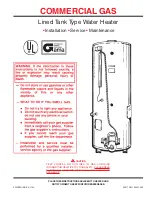
10
With the power burner installed in the heater, the electrical wiring
can be completed. On ***81-140 and ***81-199 models, remove
the power burner backplate and fasten the conduit assembly to
the power burner assembly. Next, connect the black wire to the
terminal marked “1” and the white wire to the terminal
marked “2”.
On ***81-270 and ***81-370 models, remove the two screws
above and below the control board on the junction box cover of
the power burner. Swing the junction box cover open and fasten
the conduit assembly in one of the knock-out holes in the side of
the junction box. Connect the black wire to the terminal marked
“1” and the white wire to the terminal marked “2”.
Finally, bring electrical power to the junction box mounted on the
heater jacket. Fasten conduit to any convenient knock-out hole
in the junction box. Use the two wire nuts from the shipping bag
to connect the hot and neutral conductors to the black and white
wires, respectively. Connect the ground conductor to the ground
screw in the back of the junction box.
Check all electrical connections to be sure that they are proper
and secure.
DO NOT ENERGIZE THE BRANCH CIRCUIT BEFORE THE
HEATER TANK IS FILLED WITH WATER.
WATER LINE CONNECTION
This manual provides detailed installation diagrams (see pages
12-16) of this manual for typical methods of application for the
water heaters.
The water heater may be installed itself, or with a separate storage
tank, on both single and two-temperature systems. When used
with a separate storage tank, the circulation may be either by
gravity or by means of a circulating pump. When a circulating
pump is used it is important to note that the flow rate should be
slow so that there will be a minimum of turbulence inside the
heater.
If a water heater is installed in a closed water system, contact the
water supplier or local plumbing inspector on how to control this
situation.
WATER (POTABLE) HEATING AND SPACE
HEATING (See pages 12-16)
1. All piping components connected to this unit for space heating
applications shall be suitable for use with potable water.
2. Toxic chemicals, such as those used for boiler treatment, shall
NEVER be introduced into this system.
3. This unit may NEVER be connected to any existing heating
system or component(s) previously used with a non-potable
water heating appliance.
4. When the system requires water for space heating at
temperatures higher than required for domestic water
purposes, a tempering valve must be installed. Please refer
to installation diagrams on pages 12-16 of this manual for
suggested piping arrangements.
CAUTION
A closed system will exist if a check valve (without bypass),
pressure reducing valve (without bypass), or a water meter
(without bypass) is installed in the cold water line between the
water heater and street main (well).
Excessive pressure may develope in such closed systems,
causing premature tank failure or intermittent relief valve operation.
This is not a warranty failure. An expansion tank or similar device
may be required in the inlet supply line between the appliance
and the meter or valve to compensate for the thermal expansion
of the water.
SYSTEM CONNECTIONS
The system installation must conform to these instructions and
to the local code authority having jurisdiction. Good practice
requires that all heavy piping be supported.
RELIEF VALVE
This heater is equipped with an approved temperature and
pressure relief valve. ASME ratings cover pressure relief. A.G.A.
ratings cover release rate with temperature actuation.
Your local code authority may have other specific relief valve
requirements.
WARNING
THE PURPOSE OF RELIEF VALVE IS TO AVOID EXCESSIVE
PRESSURE OF TEMPERATURE INTO THE STEAM RANGE,
WHICH MAY CAUSE SCALDING AT FIXTURES, TANK
EXPLOSION, SYSTEM OR HEATER DAMAGE. NO VALVE IS
TO BE PLACED BETWEEN THE RELIEF VALVE AND THE
TANK.
A DRAIN LINE MUST BE CONNECTED TO THE RELIEF VALVE
TO DIRECT DISCHARGE TO A SAFE LOCATION TO AVOID
SCALDING OR WATER DAMAGE. THIS LINE MUST NOT BE
REDUCED FROM THE SIZE OF THE VALVE OUTLET AND
MUST NOT CONTAIN VALVES, RESTRICTIONS NOR SHOULD
IT BE LOCATED IN FREEZING AREAS. DO NOT THREAD OR
CAP THE END OF THIS LINE. RESTRICTED OR BLOCKED
DISCHARGE WILL DEFEAT THE PURPOSE OF THE VALVE
AND IS UNSAFE. INSTALL DISCHARGE LINE TO ALLOW
COMPLETE DRAINAGE OF BOTH THE VALVE AND LINE.
THERMOMETERS (Not Supplied)
Thermometers should be obtained and field installed as shown
in the installation diagrams.
Thermometers are installed in the system as a means of detecting
the temperature of the outlet water supply.











































